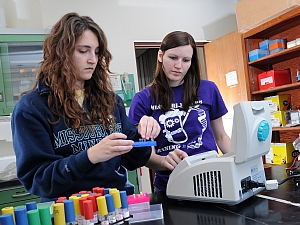
Erica Shannon, left, and Amanda Foster are among the Missouri S&T students that developed a biological system to detect glucose levels.
A team of Missouri University of Science and Technology students in Rolla developed a sensor based on genetically modified E. coli bacteria to detect glucose levels. The students, members of the university’s chapter of the International Genetically Engineered Machine (iGem) Foundation, developed the system as part of an annual competition sponsored by iGEM, receiving a silver medal for their entry.
The group devised a system that uses segments of DNA embedded in bacteria to detect glucose. The students designed genes that allow a non-virulent strain of E. coli bacteria to sense the presence of the simple sugar glucose. When glucose is present, the bacteria then emit a yellow glow, and as glucose concentrations increase, the glow becomes brighter.
According to chapter president Erica Shannon, a senior in biological sciences, this kind of sensor could lead to less costly processes to help people with diabetes monitor their blood-sugar levels. For example, a simple paper test strip could indicate glucose levels based on changes in colors, rather than a fluorescent gene, with different colors indicating safe, borderline, or dangerous levels.
“All you would have to do is put the DNA inside a bacteria and you’ve got your test strip,” says Shannon, but the potential for the technology goes further. “[B]ased on further research” Shannon adds, “an insulin gene could be added to this system for use in insulin pumps, where specific glucose levels trigger insulin production.”
Read more: Dried Blood Test Developed, Spin-Off Company Formed
* * *

 RSS - Posts
RSS - Posts
[…] Student Project Develops Bacteria-Based Glucose Sensor […]